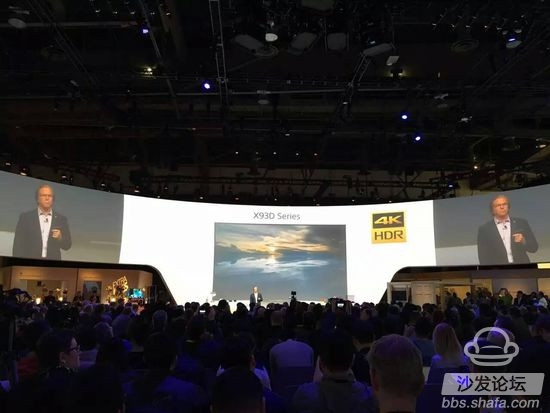The emergence of HDR technology can improve the brightness of the TV display. To put a very simple example, when the TV displays brighter, darker images with different brightness, we are likely to be the overall The brightness changes while ignoring some of the dim, or rather bright, detail effects of the TV picture.

How to make HDR better?
Take the Sony X93D series machine as an example, this TV is equipped with the elite version of the dynamic backlight system, which can achieve a very good contrast of light and shade, while the TV body can also maintain a very thin body. It can be done through the control of the backlight, controlling the light, the lightness and darkness of the LED light, while achieving better brightness and darker details.

At present, many brands discuss the wide color gamut, but the fundamental purpose of the wide color gamut is to expand the color gamut that the human eye can see. The wide color gamut technology is to widen the color gamut that the television can cover.
Taking BT709 as an example (standard color gamut), it is such a range from the point of view, but as the brightness is not the same, the brightness changes from 1 to 100 such that the color changes. With the latest BT2020 and HDR, the BT2020 expands the entire color gamut from the bottom, but HDR further widens the range of brightness from the height, so the entire color space will become very large. Because its brightness range is increased, the concept of the entire color will be greatly improved. This requires TV has a very good technology to control these colors, not to say that the color is good, the color is too much if you do not control well , there will be a lot of color cast, which requires very good technology to control this color change.
·What do you think about HDR TV?

HDR shooting technology can be realized long ago. For example, the well-known "Yueyue Biography" uses the equipment that supports HDR technology to shoot, but the "Yueyue Biography" that we see through the TV is not HDR signal. At present, professional content providers such as Amazon are already making HDR-related content and providing playback, but of course it takes a long time to wait until HDR-related resources are widely available.
Are there any relevant HDR standards?
Although we can see that most of the new color TVs on display at CES are equipped with HDR-related technologies, there is indeed no unified standard. The "true HDR standard" put forward by relevant brands a few days ago seems to be an interpretation of the need for hardware to meet certain standards when color TV needs HDR configuration. For example, on the small issue of whether HDR TV must achieve 4K resolution, there will be objections among companies, but it is not difficult to be sure that HDR technology has become a key trend in the development of color TV products.

In fact, the earliest applications of HDR technology are on cameras, mobile phones and other devices, and we can also record and shoot HDR-compliant content resources through related devices. However, when we took the content of these HDR standards to the TV for playback, we found that the content of the TV output was compressed. It may be that the picture we see is not related to HDR.
How to make HDR better?
Take the Sony X93D series machine as an example, this TV is equipped with the elite version of the dynamic backlight system, which can achieve a very good contrast of light and shade, while the TV body can also maintain a very thin body. It can be done through the control of the backlight, controlling the light, the lightness and darkness of the LED light, while achieving better brightness and darker details.

At the same time, at the Sony booth, we can see that there is a master version of the backlight system. Although there is no specific product yet, it can achieve better HDR effects than the elite version. It can achieve brightness of 4000 nits and more than 1000. Light control area. With the unique XDR technology and sophisticated light control technology, the brightness of the brightest picture area can be increased by 3 times, and the darkest area can reach completely without brightness, so that a very high contrast ratio and better brightness can be produced.
At present, many brands discuss the wide color gamut, but the fundamental purpose of the wide color gamut is to expand the color gamut that the human eye can see. The wide color gamut technology is to widen the color gamut that the television can cover.
Taking BT709 as an example (standard color gamut), it is such a range from the point of view, but as the brightness is not the same, the brightness changes from 1 to 100 such that the color changes. With the latest BT2020 and HDR, the BT2020 expands the entire color gamut from the bottom, but HDR further widens the range of brightness from the height, so the entire color space will become very large. Because its brightness range is increased, the concept of the entire color will be greatly improved. This requires TV has a very good technology to control these colors, not to say that the color is good, the color is too much if you do not control well , there will be a lot of color cast, which requires very good technology to control this color change.
·What do you think about HDR TV?

HDR shooting technology can be realized long ago. For example, the well-known "Yueyue Biography" uses the equipment that supports HDR technology to shoot, but the "Yueyue Biography" that we see through the TV is not HDR signal. At present, professional content providers such as Amazon are already making HDR-related content and providing playback, but of course it takes a long time to wait until HDR-related resources are widely available.
Are there any relevant HDR standards?
Although we can see that most of the new color TVs on display at CES are equipped with HDR-related technologies, there is indeed no unified standard. The "true HDR standard" put forward by relevant brands a few days ago seems to be an interpretation of the need for hardware to meet certain standards when color TV needs HDR configuration. For example, on the small issue of whether HDR TV must achieve 4K resolution, there will be objections among companies, but it is not difficult to be sure that HDR technology has become a key trend in the development of color TV products.